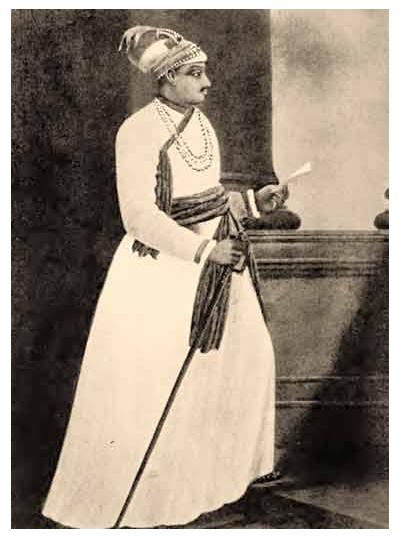On 20 June 1756, 123 Britons perished in a tiny dungeon cell in the city of Calcutta. The incident, which soon became known as the Black Hole of Calcutta, illustrated only too well that the Indian race, when left without Britain’s civilizing influence, was barbaric in the extreme.
 In April 1756, the nawab (provincial governor) of Bengal died and the throne passed to his 23-year-old grandson, Siraj-ud-Daulah (pictured), a name that was soon to become infamous in Britain as the ultimate in perfidy and cruelty. The British had been hastily strengthening Fort William in Calcutta (Kolkata) against possible future French incursion into the city. When Siraj-ud-Daulah demanded that the British desist, the British refused – it was they, after all, that had, in 1690, established Calcutta in the first place. Siraj-ud-Daulah marched into the city with 50,000 men and 500 elephants and, imposing his authority, took it with relative ease.
In April 1756, the nawab (provincial governor) of Bengal died and the throne passed to his 23-year-old grandson, Siraj-ud-Daulah (pictured), a name that was soon to become infamous in Britain as the ultimate in perfidy and cruelty. The British had been hastily strengthening Fort William in Calcutta (Kolkata) against possible future French incursion into the city. When Siraj-ud-Daulah demanded that the British desist, the British refused – it was they, after all, that had, in 1690, established Calcutta in the first place. Siraj-ud-Daulah marched into the city with 50,000 men and 500 elephants and, imposing his authority, took it with relative ease.
Black Hole
The British fled – but not all managed to escape in time. On 20 June 1756, those left behind, 146 soldiers and civilians, including two women, surrendered. Despite assurances that they would be protected, they were imprisoned on the apparent orders of Siraj-ud-Daulah in a tiny cell within Fort William measuring only 18 feet by 14 feet, 10 inches, with only two small windows. Screams and appeals for water were ignored. The prisoners were left to suffocate in the oppressive summer heat, sucking the perspiration from their shirts for liquid or drinking their own urine.
When, the following morning, the door was opened only 43 were still alive. The dead, with no room to fall, remained on their feet. One of the survivors was John Zephaniah Holwell, an Irish-born doctor and commander of the city and a future, albeit briefly, governor of Bengal. Returning to England eight months later, Holwell spent the five-month voyage writing up the tragedy of the Black Hole of Calcutta in his narrative, A Genuine Narrative of the Deplorable Deaths of the English Gentlemen and others who were suffocated in the Black Hole. Holwell writes of ‘a night of horrors [which] I will not attempt to describe, as they bar all description’, and then proceeds to describe the night in detail.
Exaggeration
Holwell’s tale caused uproar in Britain. It was not for another century and a half that historians began to question Holwell’s account, pointing to various flaws in his account. If not the event itself, then certainly the numbers involved were questioned – no more than sixty-nine could possibly have been imprisoned. Holwell may well have exaggerated the event as a means of deflecting blame for having surrendered in the first place. The Nawab was shown to have had no knowledge or input into the incarceration of the prisoners.
But in 1756, people were too busy braying for Siraj-ud-Daulah’s blood to be too concerned about precise numbers or details. British pride had to be restored and it was to Robert Clive they turned.
Battle of Plassey
 In January 1757, Clive (pictured) retook Calcutta without difficulty, forcing Siraj-ud-Daulah to flee.
In January 1757, Clive (pictured) retook Calcutta without difficulty, forcing Siraj-ud-Daulah to flee.
Six months later, on 23 June 1757, in a village called Plassey (now Palashi), 90 miles north of Calcutta, the opposing armies met. Clive’s force of just 3,000 men seemed, on paper at least, outnumbered 17 to 1 by Siraj-ud-Daulah’s 50,000 men, which included a sizeable French element. But Clive had struck a bargain with Siraj-ud-Daulah’s disaffected army chief, Mir Jafar.
As battle was joined, Mir Jafar held his men back and Siraj-ud-Daulah’s men, poorly trained, ill-equipped, and many dosed up on opium, were no match for the British who suffered little more than 70 killed or wounded. The Indian commanders strode around on bejewelled elephants intended to instill fear in the enemy but the British simply shot at the beasts causing them to stampede and wreak havoc within the Indian lines. Siraj-ud-Daulah, who had fled the field of battle on a camel, was soon caught and, on 2 July 1757, executed.
Britain had got its revenge and the Battle of Plassey ensured that it was the British, in the guise of the East India Company, that now oversaw the administration of Bengal, an area the size of France and Germany combined. Clive was appointed governor and ensured that his puppet, the new nawab, Mir Jafar, paid his dues.
The Monument
 Meanwhile, John Zephaniah Holwell commissioned an obelisk, erected at the site of the Black Hole of Calcutta, to commemorate those who lost their lives that night. It was removed in 1821.
Meanwhile, John Zephaniah Holwell commissioned an obelisk, erected at the site of the Black Hole of Calcutta, to commemorate those who lost their lives that night. It was removed in 1821.
In 1902, the new Indian viceroy, Lord Curzon, ordered that a replica should be built on the same spot. In 1940, at the insistence of the Indian independence movement, the memorial was moved to the grounds of St John’s Church in Calcutta, a church built by the East India Company in the 1780s, where it can still be seen today.
Rupert Colley.